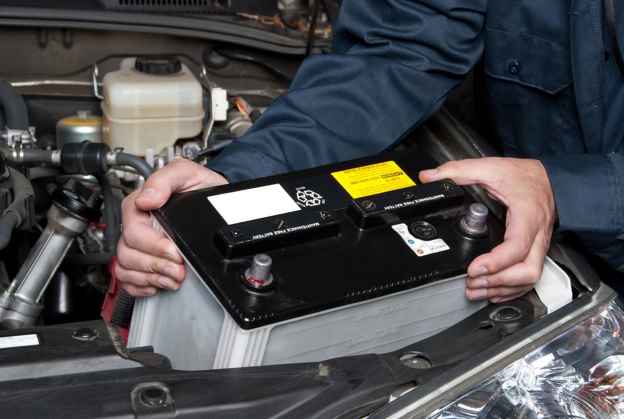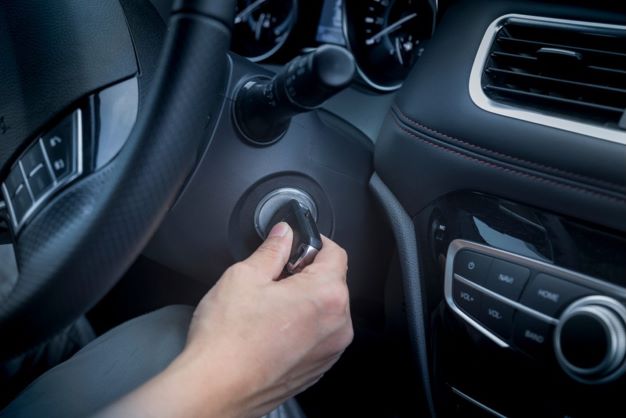You are ready to go out with your Silverado and turn the key in it, but unfortunately, your vehicle is not responding. This problem is caused by a variety of factors.
Battery problems, starter problems, and several other problems can be behind it.
Don’t worry; I have discussed those problems and their solutions here.
Silverado Turn Key Nothing Happens [7 Causes with Solutions]
7 common problems cause the Silverado not to start, including faulty battery, faulty starter, fuel pump failure, faulty alternator, bad glow plug, issues with the ignition switch, and empty fuel tank.
Let’s discuss these causes with solutions.
1. Battery Problem

If you drive your vehicle for a long time, especially in the winter, you may find battery problems.
One of the most common reasons for a vehicle not starting is a discharged or empty battery.
The vehicle’s battery is clogged in the winter, decreasing its capability.
If a battery is clogged, it may not be fully charged while driving.
A weak or discharged battery fails to process the command correctly, and you may face the problem that Silverado won’t start even after turning the key.
Symptoms of a Weak Battery
- Fuzzy headlights
- Clicking sound, but nothing happened when turning the key
- To start the vehicle, you need to press the gas pedal
- Slow crank
- Backfiring
How to Test Chevy Silverado’s Battery with a Power Probe
Here are the 05 steps to check whether the battery is functioning properly or not-
- Remove the positive and negative terminal covers of the battery
- Connect the battery-positive terminal to the power probe’s positive lead
- Connect the battery negative terminal to the power probe’s negative lead
- Connect the power probe tip to the positive battery terminal
- Check the voltage reading of the power probe
The reading of the power probe should be 12.4-12.7 volts for everyday conditions.
The battery needs to be charged if it is less than 12.4 volts.
The battery is excessively charged if the reading is more than 12.9 volts.
Solution to Silverado Battery Problem
Because of battery problems, if you fail to start the truck outside, you can use a jumper cable to receive power from another vehicle.
Always make sure you have a jumper cable in your truck.
A Silverado battery typically lasts over 3 to 5 years.
Replacing a worn-out battery is a good idea.
For further information
2. Starter Problem
If the battery is fine, but your Silverado won’t start even after turning the key, the starter may have a problem.
A starter motor runs the engine by using power from the battery.
If the magnetic switch on the starter is faulty, the starter fails to receive the command properly.
Symptoms of a Bad Starter
- Engine will not turn
- Starter remains on after the engine starting
- Intermittent starting issues
- Clicking, whirring noises
- Smell of smoke
- Battery problems also cause starter problems
How to Test Starter Without Removing It
Use a multimeter, clips, 12V battery, and alligator clips.
Here are 03 steps of testing-
- Attach the positive multimeter probe to the high-voltage input terminal on the starter solenoid
- Connect the multimeter negative lead to a metal exterior by using alligator clips
- The multimeter shows 12 volts if the starter is functioning properly, and the voltage decreases when you start the engine
Solution of the Starter Problem
Fixing a starter is complicated as it is situated deep in the engine.
You can take the help of a qualified mechanic to solve the starter problem.
Typically a Chevy Silverado’s starter lasts over 100,000 to 160,000 miles.
If the starter is old enough, replace it.
3. Fuel Pump Problem

If there is any problem with the fuel system, it causes an engine starting problem.
Sometimes there is enough fuel in the fuel tank, but due to a fault in the system, the fuel is obstructed from reaching the cylinder. As a result, the engine will not start.
This problem leads to engine starting issues
Symptoms of a Faulty Fuel Pump
- Engine doesn’t start
- Overheating engine
- Engine runs slowly
- Reduced fuel mileage
- Abnormal speed
Solution of the Problem
Taking the vehicle to a qualified mechanic is a wise move, as the problem needs to be identified very carefully.
Sometimes just the incorrect setting of the fuel pump creates the starting problem, which can be solved easily.
4. Faulty Alternator

An alternator is an extremely vital electric part of a vehicle.
It recharges the vehicle’s battery and distributes electricity.
If the alternator is faulty, it causes the Silverado to start problems.
Symptoms of a Faulty Alternator
- Malfunctioning accessories
- Frequent stalling or starting problem
- Dim lights
- Smells like burning rubber
- Dead battery
- Battery warning light
Solutions for Faulty Alternator Issues
I suggest hiring a mechanic for normal repair, because if you attempt to repair it, it may create several new problems.
However, if you find major issues or the alternator reaches 80,000 to 155,000 miles, you should replace it.
A Chevrolet Silverado 1500 alternator replacement costs around $600 to $750, including labor and a serpentine belt.
5. Empty Fuel Tank

Your Silverado may not start after turning the key because of the low or empty fuel tank.
A vehicle needs fuel to start its engine.
Sometimes when you are out for a long drive or if you forget to refill fuel, you may face vehicle starting problems.
Symptoms of an Empty Fuel Tank
- The vehicle stalls
- The fuel gauge sign on the dashboard shows low or empty fuel
How to Check Fuel Tank
Use your owner’s manual to check the fuel capacity in your vehicle’s fuel tank.
The Chevy Silverado 1500 fuel tank capacity is 24.0 gallons.
Solutions for Empty Fuel Tanks
Fill up your fuel tank with premium fuel for the most efficient performance.
Check your fuel tank before leaving for a long drive.
6. Faulty Ignition Switch

The ignition switch transmits power from the battery to vehicle components.
A bad ignition switch causes you to have problems starting because it fails to supply power adequately.
Symptoms of a Faulty Ignition Switch
- Vehicle starts and then abruptly stalls
- The engine may not start
- Vehicle may stall while driving
- Accessories powering issues
- Turning key issues
Solutions for Wrong Ignition Switch Issues
As several electrical systems are connected to the ignition switch.
If the switch has a problem, it causes many other problems, sometimes even causing the engine to shut down.
In such cases, replacing the faulty switch is the most appropriate solution.
It costs around $200 to replace (depending on model and year), including labor costs.
You can watch the video if you want to replace the switch yourself
7. Glow Plug Problem
A faulty glow plug also affects vehicle starting.
You might have trouble starting the engine if the glow plug is damaged.
Symptoms of a Faulty Glow Plug
- Hard starting
- Rough idling
- Engine misfiring
- Reduced fuel mileage
Solution for Bad Glow Plug Problem
A Chevy Silverado glow plug lasts up to 100,000 miles.
After this period, you should replace it.
It cost you approximately $300.
If the glow plug fails before the specified distance, I suggest contacting a mechanic for repair.
Other Reasons
Sensitivity issues also cause vehicle starting problems.
Modern vehicles have security codes, which help to allow the start engine only for the correct key.
If there is any malfunction with the security code, you will have difficulty starting the vehicle.
Usually, when you turn the ignition on, a “Check Engine” light indicates that the ECU is powered on.
If the indicator light does not pop on, no power may pass to the engine computer, resulting in engine stalls.
Other causes for the turn-key not responding may be a damaged engine, faulty crankshaft sensor, a flooded carburetor, moisture inside the engine, a clogged fuel line, etc.
Solutions to Code Issue
Reprogramming may fix the security code issues.
For further problems, take the vehicle to a repair shop for a better diagnosis.
FAQs
Why won’t the key turn on my Chevy Silverado?
Key may not turn on your Silverado for many reasons. Steering column locks, key issues or the ignition module issue are the common reasons. Faulty battery, alternator issue, bad fuel pump etc. are other reasons for the truck not to start. Diagnose the vehicle properly while you face this problem. Contact the dealership or nearby mechanic shop for repair and maintenance.
What does a Chevy ignition control module do?
Ignition control module plays an important role in running the vehicle. It controls the voltage through the ignition coil to start a fire. Ignition coil causes sparks in the spark plugs that ignite the air fuel mixture in the engine. Ignition produces intense pressure that cranks the engine to run the truck. You won’t be able to start the vehicle without an ignition control module.
Where is the ignition control module located?
Generally, the ignition control module stays close to the engine. You can find the module under the engine hood. It can be installed next to the ignition coils or the distributor. In present times the control module is integrated into the ECM and doesn’t have a separate entity.
What’s the signs of a bad ignition switch?
You can easily detect ignition switch issues by looking for a few symptoms:
- Failed to start the truck
- Vehicle stalls suddenly
- Ignition key not working
- Difficulty turning the key
- Silent motor start
- Ignition malfunctioning
- Blinking or loss of power in the dashboard and other equipment
You should diagnose the ignition system as soon as possible to avoid any serious issues. Look out for the signs and get assistance from professionals to fix the issue.
How do I test my ignition system?
Follow the 02 steps to test your ignition system:
- Check ignition coils: Test the ignition coils starting with disconnecting the spark plug wires and connecting a tester to the high output terminal of the coils. Crank the engine and look for spark readings. Steady and continuous sparks mean the ignition coil is good. Low spark or no spark means faulty ignition coil. You can also check the resistance of the ignition coil. Multimeter reading or resistance should be around 100 and 200 Ohms.
- Check ignition module: Previously ignition modules had separate entities which were merged with the ECM later. Use the OBD-II scanner to examine the ignition module in the ECM. P0300 to P0399 are the error codes you should look for. These codes indicate the problem in those parts.
How much does it cost to replace an ignition switch?
Ignition switches are cheap to replace. You can easily replace them. Ignition switch costs $65 to $100 for the parts. Labor cost is around $80-$150 and the total replacement cost is $145 to $250.
Final Thoughts
First, find out why your Silverado is not starting, then apply the solution mentioned in this article.
In case you are not able to do the mechanical work yourself, you may want to hire a mechanic to help you.
Want to explore other problems with the Chevy Silverado? Check out the following articles:

